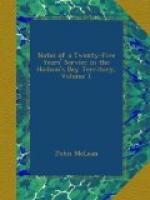There are seven posts in this district; three on the River Liard and its tributaries; three on the banks of McKenzie’s River, and one on Peel’s River. About two degrees to the north of Good Hope, Fort Simpson, the depot of the district, is situated at the confluence of the Liard and McKenzie, in lat. 61 deg. north. Heat and cold are here felt in the extremes; the thermometer frequently falls to 50 deg. minus in winter, and rises sometimes to 100 deg. in the shade in summer. The River Liard has its source in the south among the Rocky Mountains: its current is remarkably strong; and in the early part of summer, when swollen by the melting of the snow, it rushes down in a foaming torrent, and pours into the McKenzie, still covered with solid ice, when a scene ensues terrific and grand:—the ice, resisting for some time the force of the flood, ultimately gives way with the noise of thunder, and clashing, roaring and tumbling, it rolls furiously along until it accumulates to such an extent as to dam the river across. This again presents, for a time, a solid barrier to the flood, which is stopped in its course; it then rises sometimes to the height of thirty and forty feet, overflowing the adjacent country for miles, and levelling the largest trees with the ground. The effects of this frightful conflict are visible in all the lower grounds along the river. The trading posts are situated on the higher grounds, yet they are not secure from danger. Fort Good Hope was swept clean away some years ago, and its inmates only saved themselves by getting into a boat that happened fortunately to be at hand. The McKenzie opens about the end of May, and is ice-bound in November.
The tribes who inhabit the banks of the McKenzie, and the interior parts of the district, are members of the powerful and numerous Chippewayan family, and are known by the names of Slaves, Dogribs, Rabbitskins, and Gens des Montagnes. The Loucheux, or Squint-Eyes, frequent the post on Peel’s River, and speak a different language; their hunting-grounds are within the Russian boundary, and are supposed to be rich in fur-bearing animals. The Loucheux have no affinity with the Chippewayan tribes, nor with their neighbours, the Esquimaux, with whom, however, they maintain constant intercourse, though not always of the most friendly kind, violent quarrels frequently occurring between them. The various dialects spoken by the other tribes are intelligible to all; in manners, customs, and personal appearance, there is also the closest similarity.
In one point, however, these tribes differ, not only from the parent tribe, but from all the other tribes of America;—they treat their women with the utmost kindness, the men performing all the drudgery that usually falls to the women. Here the men are the hewers of wood and drawers of water; they even clear away the snow for the encampment; and, in short, perform every laborious service. This is indeed passing strange;—the Chippewayans,




